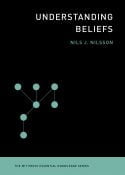
MIT Press
ISBN 10: 0262526433
This slim book is part of MIT’s Essential Knowledge series. The term “knowledge”, however, seems to pose some difficulties for the author. In his glossary, he defines knowledge as “the sum total of one’s information about a subject or subjects”, although the term “information” does not feature in the glossary or the index. But compare this to his definition of “know”: “a word used for a belief held very, very strongly”.
That is certainly not how I use the word, or I would be unable to distinguish between those who know something and those who are convinced that they know something but are mistaken. Of course, I must often, unfortunately, include myself in the latter set, but therein lies a key point: it would not be possible for us to have acquired the concept of a mistake if what we believed were always true. Nilsson reports on p.xii that he cannot “distinguish knowledge from belief in a qualitatively meaningful way”.
For Nilsson, everything reduces to beliefs: explanations are beliefs, and all declarative sentences stored in a computer are its beliefs. (Nilsson also reveals in the Preface that he has not grasped the distinction between a statement or proposition and the various sentences that may express it.)
Beguiled by casual usage and technical jargon like “knowledge base”, Nilsson endows the computer with a set of beliefs which are indistinguishable from knowledge. Does the computer “hold its beliefs” equally strongly? It would presumably have to hold them very strongly for them to count as knowledge.
The force of that venerable slogan, Garbage In, Garbage Out, eludes him. Suppose a computer could be given The Knowledge – a detailed, working map of London – while another was given a map with randomised street names and a distorted scale. What kind of knowledge would that be?
Nilsson presents us with a diagram he calls a network of beliefs. This links observations about rising sea levels, at one end, to carbon dioxide increases at the other, via global warming, with explanations going in that direction and consequences in the other. But are the nodes in this network physical phenomena or beliefs about them? How could a belief in rising sea levels be a consequence of a belief in increasing carbon dioxide? The author seems to find this diagram useful, as it pops up again, fifteen pages later, exactly the same apart from a brand new title: “a Bayesian belief network”.
Certainly, the problems of epistemology are never straightforward, but despite a chapter outlining the history of science and a cautionary chapter on belief traps, it does not seem that they are made any clearer at all in this book.
Paul Taylor



